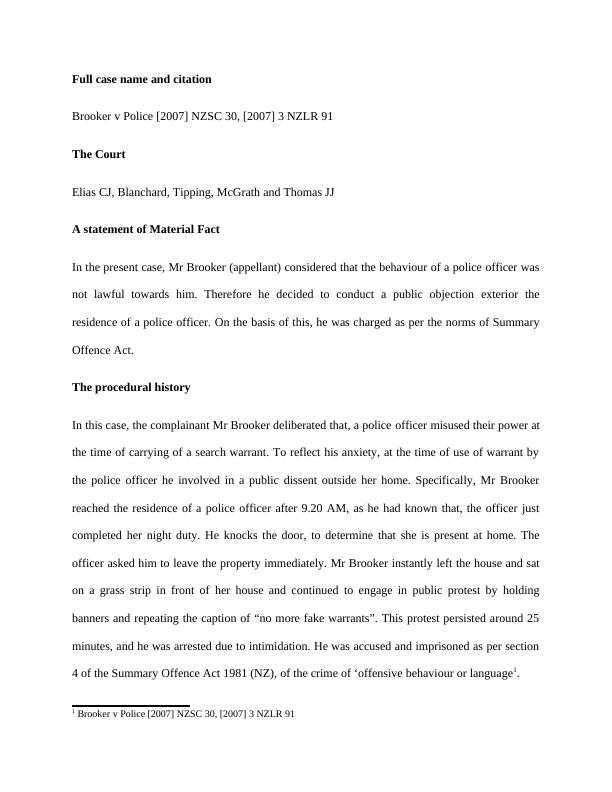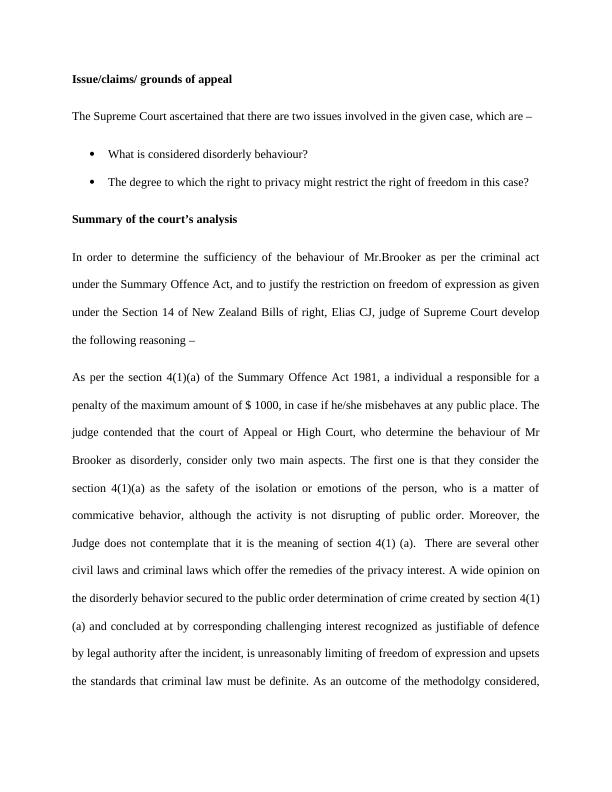Case Analysis & Statutory Interpretation
Added on 2023-01-24
6 Pages1201 Words87 Views
Case Analysis & Statutory Interpretation
Assignment
Assignment

Full case name and citation
Brooker v Police [2007] NZSC 30, [2007] 3 NZLR 91
The Court
Elias CJ, Blanchard, Tipping, McGrath and Thomas JJ
A statement of Material Fact
In the present case, Mr Brooker (appellant) considered that the behaviour of a police officer was
not lawful towards him. Therefore he decided to conduct a public objection exterior the
residence of a police officer. On the basis of this, he was charged as per the norms of Summary
Offence Act.
The procedural history
In this case, the complainant Mr Brooker deliberated that, a police officer misused their power at
the time of carrying of a search warrant. To reflect his anxiety, at the time of use of warrant by
the police officer he involved in a public dissent outside her home. Specifically, Mr Brooker
reached the residence of a police officer after 9.20 AM, as he had known that, the officer just
completed her night duty. He knocks the door, to determine that she is present at home. The
officer asked him to leave the property immediately. Mr Brooker instantly left the house and sat
on a grass strip in front of her house and continued to engage in public protest by holding
banners and repeating the caption of “no more fake warrants”. This protest persisted around 25
minutes, and he was arrested due to intimidation. He was accused and imprisoned as per section
4 of the Summary Offence Act 1981 (NZ), of the crime of ‘offensive behaviour or language1.
1 Brooker v Police [2007] NZSC 30, [2007] 3 NZLR 91
Brooker v Police [2007] NZSC 30, [2007] 3 NZLR 91
The Court
Elias CJ, Blanchard, Tipping, McGrath and Thomas JJ
A statement of Material Fact
In the present case, Mr Brooker (appellant) considered that the behaviour of a police officer was
not lawful towards him. Therefore he decided to conduct a public objection exterior the
residence of a police officer. On the basis of this, he was charged as per the norms of Summary
Offence Act.
The procedural history
In this case, the complainant Mr Brooker deliberated that, a police officer misused their power at
the time of carrying of a search warrant. To reflect his anxiety, at the time of use of warrant by
the police officer he involved in a public dissent outside her home. Specifically, Mr Brooker
reached the residence of a police officer after 9.20 AM, as he had known that, the officer just
completed her night duty. He knocks the door, to determine that she is present at home. The
officer asked him to leave the property immediately. Mr Brooker instantly left the house and sat
on a grass strip in front of her house and continued to engage in public protest by holding
banners and repeating the caption of “no more fake warrants”. This protest persisted around 25
minutes, and he was arrested due to intimidation. He was accused and imprisoned as per section
4 of the Summary Offence Act 1981 (NZ), of the crime of ‘offensive behaviour or language1.
1 Brooker v Police [2007] NZSC 30, [2007] 3 NZLR 91

Issue/claims/ grounds of appeal
The Supreme Court ascertained that there are two issues involved in the given case, which are –
What is considered disorderly behaviour?
The degree to which the right to privacy might restrict the right of freedom in this case?
Summary of the court’s analysis
In order to determine the sufficiency of the behaviour of Mr.Brooker as per the criminal act
under the Summary Offence Act, and to justify the restriction on freedom of expression as given
under the Section 14 of New Zealand Bills of right, Elias CJ, judge of Supreme Court develop
the following reasoning –
As per the section 4(1)(a) of the Summary Offence Act 1981, a individual a responsible for a
penalty of the maximum amount of $ 1000, in case if he/she misbehaves at any public place. The
judge contended that the court of Appeal or High Court, who determine the behaviour of Mr
Brooker as disorderly, consider only two main aspects. The first one is that they consider the
section 4(1)(a) as the safety of the isolation or emotions of the person, who is a matter of
commicative behavior, although the activity is not disrupting of public order. Moreover, the
Judge does not contemplate that it is the meaning of section 4(1) (a). There are several other
civil laws and criminal laws which offer the remedies of the privacy interest. A wide opinion on
the disorderly behavior secured to the public order determination of crime created by section 4(1)
(a) and concluded at by corresponding challenging interest recognized as justifiable of defence
by legal authority after the incident, is unreasonably limiting of freedom of expression and upsets
the standards that criminal law must be definite. As an outcome of the methodolgy considered,
The Supreme Court ascertained that there are two issues involved in the given case, which are –
What is considered disorderly behaviour?
The degree to which the right to privacy might restrict the right of freedom in this case?
Summary of the court’s analysis
In order to determine the sufficiency of the behaviour of Mr.Brooker as per the criminal act
under the Summary Offence Act, and to justify the restriction on freedom of expression as given
under the Section 14 of New Zealand Bills of right, Elias CJ, judge of Supreme Court develop
the following reasoning –
As per the section 4(1)(a) of the Summary Offence Act 1981, a individual a responsible for a
penalty of the maximum amount of $ 1000, in case if he/she misbehaves at any public place. The
judge contended that the court of Appeal or High Court, who determine the behaviour of Mr
Brooker as disorderly, consider only two main aspects. The first one is that they consider the
section 4(1)(a) as the safety of the isolation or emotions of the person, who is a matter of
commicative behavior, although the activity is not disrupting of public order. Moreover, the
Judge does not contemplate that it is the meaning of section 4(1) (a). There are several other
civil laws and criminal laws which offer the remedies of the privacy interest. A wide opinion on
the disorderly behavior secured to the public order determination of crime created by section 4(1)
(a) and concluded at by corresponding challenging interest recognized as justifiable of defence
by legal authority after the incident, is unreasonably limiting of freedom of expression and upsets
the standards that criminal law must be definite. As an outcome of the methodolgy considered,

End of preview
Want to access all the pages? Upload your documents or become a member.
Related Documents
Brooker v Police: Case Analysislg...
|6
|1246
|65
Disorderly Behaviour in Summary Offenses Actlg...
|5
|601
|407
Legal Process: Constable Higgins v Woodward [2017] VSCA 00lg...
|9
|1561
|38
Case Summary: Bradshaw v Bar Association of Queenslandlg...
|7
|918
|54
ASSIGNMENT ON THE CRIMINAL LAWlg...
|8
|1154
|23
